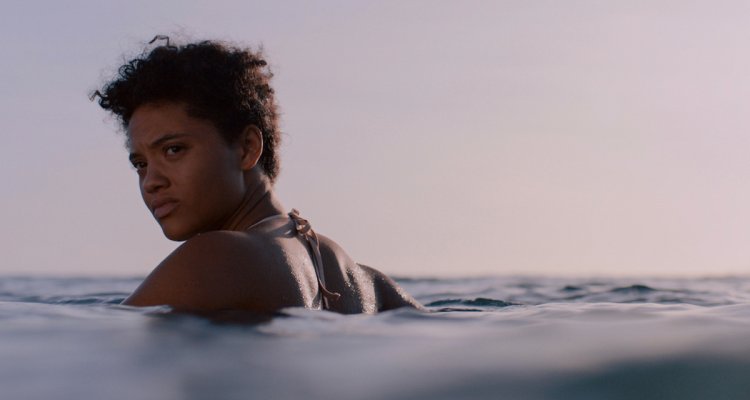Do you remember watching the pilot of “Lost” when it aired 15 years ago, one of the most tense and ominous episodes television had seen to date, with incredible characters and more mysteries than the writers knew what to do with? Audiences were on the edge of their seats, but it was the characters that drove the story. By the end of the show’s first hour, the eerie genre stakes were established, when the pilot of Oceanic Flight 815’s mangled corpse was left hanging in a canopy by an unseen monstrous entity. The beginning of the new Blumhouse horror feature “Sweetheart” owes a lot to “Lost,” playing like a monster movie version of “Cast Away;” only there’s no volleyball, and the Man in Black is some sort of Guillermo del Toro-esque shark-hybrid that hunts from the sea.
“Sweetheart,” directed by JD Dillard (“Sleight”), opens with a gorgeous shot of the ocean floor before the camera rises above the waves, revealing its protagonist, Jenn (Kiersey Clemons) washed up on an island shore. The man next to her has a piece of coral protruding from his ribcage. She screams for help, but no one is around to hear her. Walking up the beach, she finds a red cooler, a book of scary stories, and an abandoned sack with pills and linens inside.
Jenn learns of a shadowy creature lurking in the shallows after a plane flies overhead. Shooting her only flare into the night sky, a silhouette of something truly terrifying is illuminated over the dark horizon. Taking shelter in a hollowed-out log, Jenn hides from an amphibious ocean beast at night, while teaching herself to fish during the day. Soon, another pair of survivors arrive on an emergency raft, including Lucas (Emory Cohen), Jenn’s significant other, who immediately gaslights his girlfriend, after Jenn attempts to warn Lucas and their friend Mia (Hanna Mangan Lawrence) about the monster that comes each night.
Sadly, when the new characters arrive, “Sweetheart” takes an instant nosedive. The first 20 minutes of the movie are a phenomenal exercise in suspense building. The film sports great camerawork and knows how to escalate tension, but momentum stalls when the survival film aspects come to a halt and the movie morphs into an on the nose toxic relationship metaphor, much like Ari Aster’s “Midsommar,” sans any sort of character development. It’s hard to care about people you know nothing about. The film features next to no dialog until the supporting players show up, and when they do, the script does them no favors (there are somehow three credited screenwriters, also a real head-scratcher). After a strong opening act, there’s a lot of waiting for something to happen with a poorly executed and, frankly, stupid payoff.
The early minutes of the movie pepper in a ton of symbolic detail and Dillard uses this imagery in a number of stylish ways, but it’s a lot of signs and signifiers that don’t end up amounting to much, planting the story seeds of a break-up movie metaphor that soon announces itself in mansplaining form. Towards the beginning of the narrative, the weather is nothing but tropical clear skies; after Lucas arrives on the island, the sunshine is replaced by thunder clouds. The screenplay’s thematic coding is even less subtle. “You don’t know what it’s like out there,” Jenn cries when her friends refuse to believe her campfire tales about the shark monster. Lucas later gives a monologue in finger-pointing form about how she’s the cause of all their problems and should feel guilty about ruining their vacation. (Dude, you’re fighting for your life on a deserted island, maybe get over yourself?)
Luckily, the haunting synth score and terrifying sound design do the bulk of the scare work for the film. It’s a classic monster movie case of the less you show and the more you hear, the more frightening the creature is. When the movie puts the monster on full display in the final stretch, the horror established is lost. It doesn’t help that the throwaway genre padding is very “Pacific Rim,” and the film already takes a page or two of the “The Shape of Water’s” “Creature from the Black Lagoon” inspired-design playbook. The shot in which the shark-beast is first revealed is masterful, but the climax so thirsty and dumbed-down that it feels like a totally different director shot the fiery finale.
“Sweetheart” initially seems to understand why withholding information is an important aspect of building an ominous atmosphere, but the more its short, 82-minute runtime stretches, the more obvious it becomes that the movie isn’t going to get scarier than its opening. Dillard’s visual storytelling confidence subsides when horrible writing takes over. Clemons is very good though, doing her best to elevate the little she’s given to work with. There’s a gorgeous shot of a baby turtle waddling into the sea, as well as one of a black hole entrenched at the bottom of the ocean; the first shot is symbolic, the second a blip of expository worldbuilding, but much like all the mystery-box shows that tried to follow in “Lost’s” footsteps there’s little story substance to be found. [C/C-]

